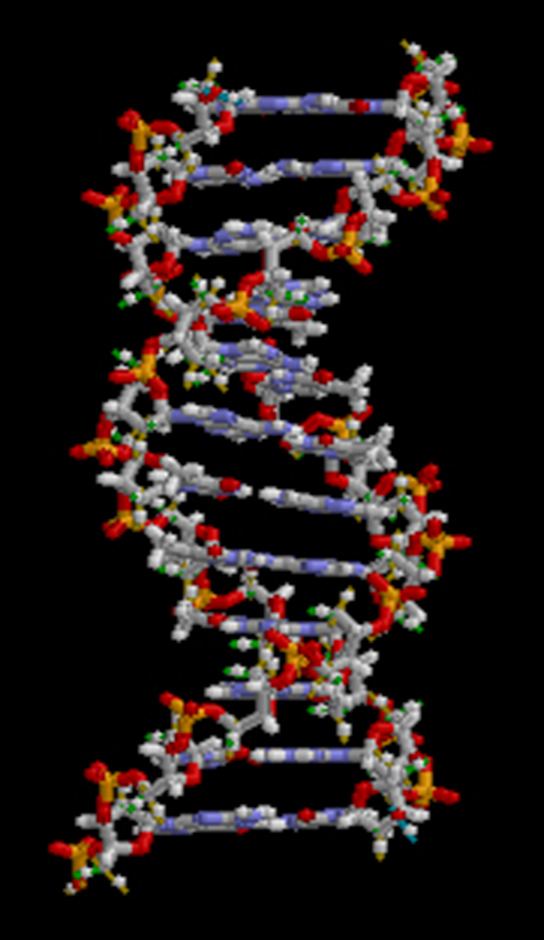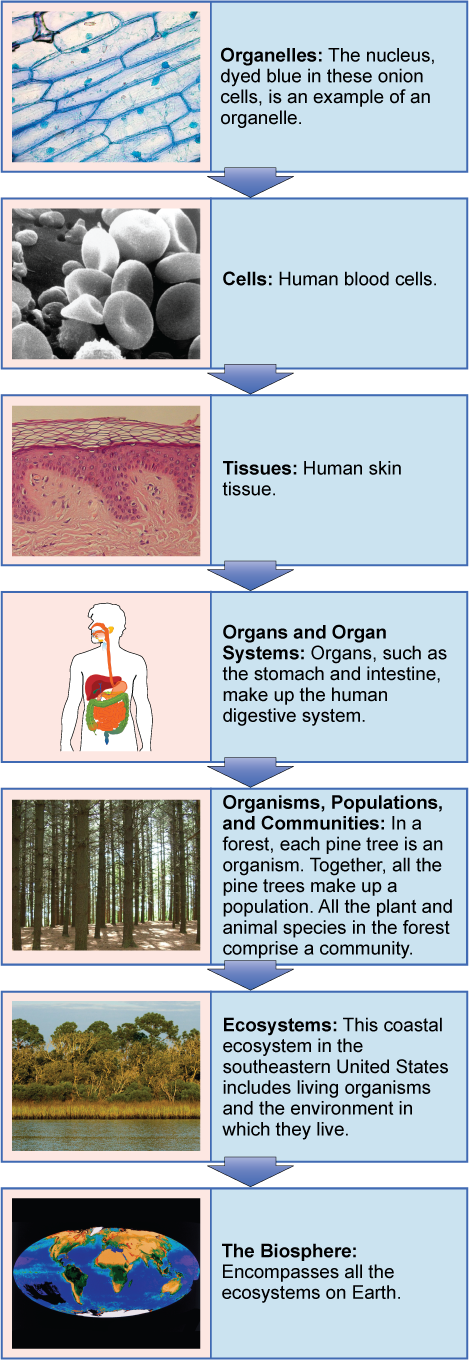Directed Reading a the Organization of Living Things Answer Key
i.2B: Levels of Organization of Living Things
- Page ID
- 12651
Learning Objectives
- Describe the biological levels of organization from the smallest to highest level
Living things are highly organized and structured, following a hierarchy that tin be examined on a scale from small to large. The cantlet is the smallest and virtually fundamental unit of matter. It consists of a nucleus surrounded by electrons. Atoms form molecules which are chemical structures consisting of at least two atoms held together by one or more chemical bonds. Many molecules that are biologically important are macromolecules, large molecules that are typically formed by polymerization (a polymer is a big molecule that is made by combining smaller units called monomers, which are simpler than macromolecules). An example of a macromolecule is dna (DNA), which contains the instructions for the structure and functioning of all living organisms.

From Organelles to Biospheres
Macromolecules tin can course aggregates within a prison cell that are surrounded past membranes; these are called organelles. Organelles are small structures that be inside cells. Examples of these include: mitochondria and chloroplasts, which bear out indispensable functions. Mitochondria produce energy to power the cell while chloroplasts enable greenish plants to use the free energy in sunlight to brand sugars. All living things are made of cells, and the cell itself is the smallest fundamental unit of construction and function in living organisms. (This requirement is why viruses are not considered living: they are not made of cells. To brand new viruses, they have to invade and hijack the reproductive machinery of a living jail cell; merely then tin can they obtain the materials they demand to reproduce. ) Some organisms consist of a unmarried cell and others are multicellular. Cells are classified equally prokaryotic or eukaryotic. Prokaryotes are single-celled or colonial organisms that do non accept membrane-leap nuclei; in contrast, the cells of eukaryotes do have membrane-jump organelles and a membrane-bound nucleus.
In larger organisms, cells combine to brand tissues, which are groups of similar cells conveying out similar or related functions. Organs are collections of tissues grouped together performing a common office. Organs are present not just in animals but too in plants. An organ system is a college level of organization that consists of functionally related organs. Mammals have many organ systems. For instance, the circulatory arrangement transports blood through the body and to and from the lungs; information technology includes organs such as the middle and blood vessels. Furthermore, organisms are individual living entities. For example, each tree in a wood is an organism. Single-celled prokaryotes and single-celled eukaryotes are too considered organisms and are typically referred to as microorganisms.
All the individuals of a species living inside a specific surface area are collectively called a population. For example, a wood may include many pine copse. All of these pine copse represent the population of pine trees in this forest. Different populations may live in the same specific area. For instance, the woods with the pine copse includes populations of flowering plants and also insects and microbial populations. A community is the sum of populations inhabiting a detail area. For instance, all of the trees, flowers, insects, and other populations in a forest grade the forest'south community. The forest itself is an ecosystem. An ecosystem consists of all the living things in a particular area together with the abiotic, non-living parts of that environs such as nitrogen in the soil or pelting water. At the highest level of system, the biosphere is the collection of all ecosystems, and it represents the zones of life on earth. It includes country, water, and even the atmosphere to a certain extent. Taken together, all of these levels contain the biological levels of organization, which range from organelles to the biosphere.

Cardinal Points
- The cantlet is the smallest and most fundamental unit of measurement of matter. The bonding of at least two atoms or more form molecules.
- The simplest level of organization for living things is a single organelle, which is equanimous of aggregates of macromolecules.
- The highest level of organisation for living things is the biosphere; it encompasses all other levels.
- The biological levels of organization of living things arranged from the simplest to most complex are: organelle, cells, tissues, organs, organ systems, organisms, populations, communities, ecosystem, and biosphere.
Key Terms
- molecule: The smallest particle of a specific chemical compound that retains the chemical properties of that compound; two or more atoms held together by chemical bonds.
- macromolecule: a very big molecule, peculiarly used in reference to large biological polymers (e.g. nucleic acids and proteins)
- polymerization: The chemical process, normally with the aid of a catalyst, to grade a polymer by bonding together multiple identical units (monomers).
Directed Reading a the Organization of Living Things Answer Key
Source: https://bio.libretexts.org/Bookshelves/Introductory_and_General_Biology/Book%3A_General_Biology_(Boundless)/01%3A_The_Study_of_Life/1.2%3A_Themes_and_Concepts_of_Biology/1.2B%3A_Levels_of_Organization_of_Living_Things